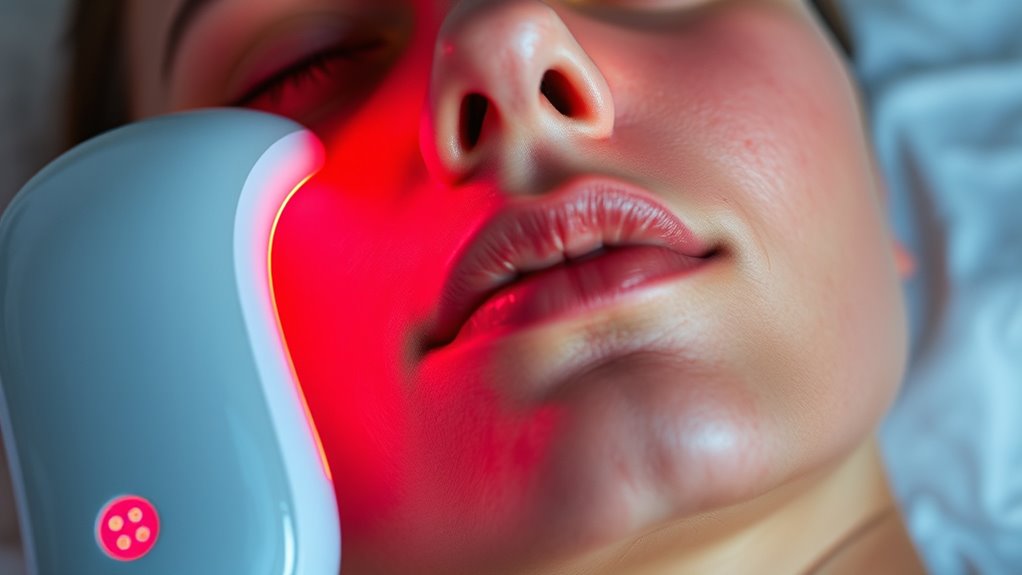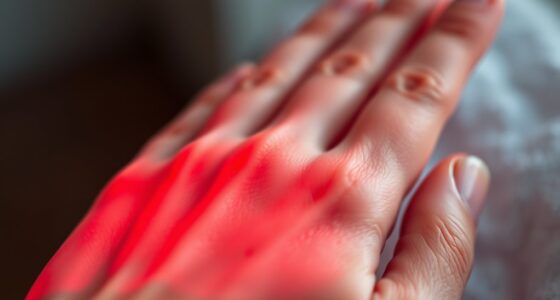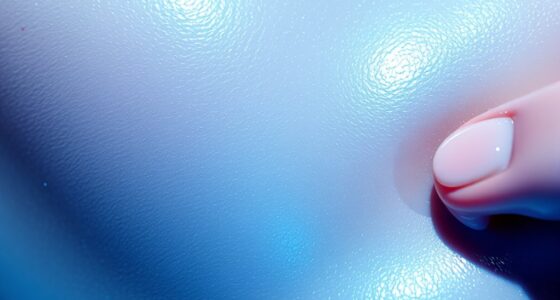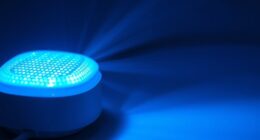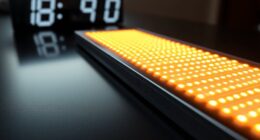For the best results with red-light therapy, aim for 3 to 5 sessions weekly, with each session lasting 10 to 20 minutes. Consistency is more important than intensity, so stick to a regular schedule and gradually increase as your body adapts. Monitor how your skin responds and adjust frequency if you notice irritation. Staying within these guidelines helps optimize your benefits—stay tuned for more tips to maximize your routine.
Key Takeaways
- Most users should aim for 3 to 5 sessions per week for optimal results.
- Each session typically lasts 10 to 20 minutes, depending on individual goals and device guidelines.
- Consistency is more important than session intensity; regular use enhances cellular repair and rejuvenation.
- Monitor skin response; reduce frequency if irritation, redness, or discomfort occurs.
- Always follow manufacturer instructions and consult professionals to personalize the optimal frequency.

Red-light therapy has gained popularity for its potential benefits, but figuring out how often to use it can be confusing. The key is understanding the right dosage frequency to achieve the best results without overdoing it. The ideal schedule varies depending on your goals, skin type, and the device you’re using, but generally, consistency is more important than intensity. Most experts recommend starting with shorter sessions a few times a week, then gradually increasing as your body adapts. This approach helps your skin and tissues respond effectively without risking irritation or diminishing returns.
When considering the dosage frequency, think of red-light therapy as a form of gentle stimulation rather than a quick fix. For general wellness or skin health, many find that 3 to 5 sessions per week, each lasting about 10 to 20 minutes, works well. This schedule allows the light to penetrate deeply enough to promote cellular repair and boost circulation, all while giving your body time to recover between sessions. If you’re targeting specific issues like pain or inflammation, some protocols suggest more frequent sessions initially, then tapering down as symptoms improve. Conversely, if you’re using red-light therapy for anti-aging or skin rejuvenation, sticking to a consistent routine over several weeks tends to generate more noticeable results.
It’s important to listen to your body and observe how your skin and tissues respond. If you notice redness, irritation, or discomfort, it might be a sign to cut back on the frequency or duration. On the other hand, if you don’t see any benefits after a few weeks, you could consider increasing your session length or frequency, but always within recommended guidelines. Consulting with a healthcare professional or following manufacturer instructions can help you establish an ideal schedule tailored to your needs.
Frequently Asked Questions
Can Red-Light Therapy Be Used Daily Without Side Effects?
Yes, you can use red-light therapy daily without significant side effects, but you should consider safety considerations and your individual response. Typically, a safe treatment frequency involves using it 3-5 times per week, but some people may benefit from daily sessions. Always follow manufacturer guidelines and consult with a healthcare professional to determine the best treatment frequency for your needs, ensuring safe and effective results.
Is There an Optimal Time of Day for Treatment Sessions?
You should aim for red-light therapy sessions in the morning or early afternoon, as studies show that morning treatments can boost energy and mood. Timing considerations suggest integrating sessions seamlessly into your daily routine, making them more effective and easier to maintain. Consistency matters most, so choose a time that fits your schedule, ensuring you stick with it for ideal results and long-term benefits.
How Long Should Each Red-Light Therapy Session Last?
You should aim for a session duration of about 10 to 20 minutes, depending on your specific device and targeted area. Keep in mind that shorter, consistent treatment sessions are often more effective than longer ones. For ideal results, stick to a regular treatment schedule, usually 3 to 5 times a week, adjusting as needed based on your skin’s response and your goals.
Can Multiple Treatments per Day Improve Results?
Research shows that some people see improved results with multiple treatments per day, but it’s essential to focus on treatment frequency and dosage optimization. You can try two sessions daily, but watch for diminishing returns or irritation. To maximize benefits, listen to your body and consult guidelines or a professional. More isn’t always better—finding the right balance guarantees effective, safe red-light therapy.
Are There Specific Skin Types That Respond Better to Red-Light Therapy?
Your skin compatibility influences how well red-light therapy works for you. Generally, those with fair to medium skin tones tend to respond better, but it’s essential to customize treatments based on your skin type. If you have sensitive or darker skin, start with shorter sessions and consult a professional to tailor the therapy. Personalizing your approach guarantees ideal results while minimizing potential irritation.
Conclusion
To get the best results from red-light therapy, stick to a consistent schedule—usually a few times a week. Think of it as watering a delicate plant; regular care helps it thrive. Don’t overdo it, or you might burn out the benefits. Listen to your body, and give your skin time to respond. With patience and regular sessions, you’ll see progress unfold like a sunrise—gradually, beautifully illuminating your wellness journey.
